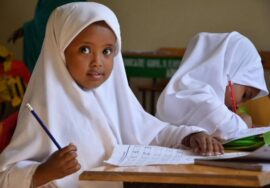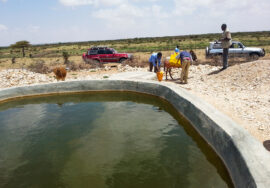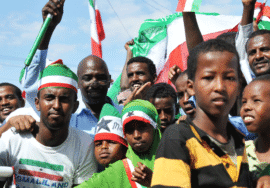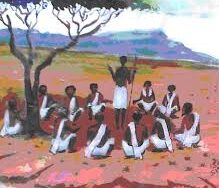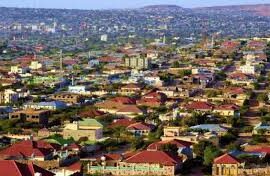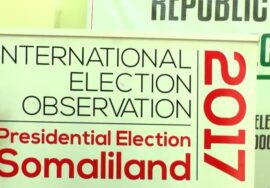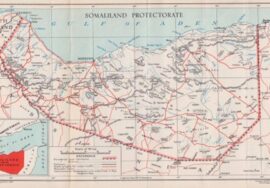
Somaliland Environmental
Somaliland Environmental Stewardship
- Background
Somaliland situated in the Horn of Africa, its boundaries are defined by the Gulf of Aden in the north, Somalia in the east, the Federal Republic of Ethiopia in the south and the Republic of Djibouti in the west. v The total area of the Republic of Somaliland is 137,600 km² with a coastline of 850 kilometers v Somaliland climate is hot, arid to semi-arid , Consists of three main topographic zones, the coastal, plains, the coastal range and the plateau v The population at around 3.5 million with a growth rate of 3.1%. & Population density is estimated at approximately 25 persons per sq kilometer v 55% of the population is either nomadic or seminomadic, while 45% live in urban centers or rural towns v Pastoralism is the principle mode of production in most parts of the country whereby inhabitants with their livestock (cattle, camels, sheep/goats).
The ecological zones of Somaliland is classified: guban and golis that provide good grazing for goat and camel while the haud provide good grazing for camel, goat and sheep at the same time in some pockets (Borama , Gabiley and Odwyene) the haud also referred to as “Ogo” and is good for cereal production vDue to the arid nature of the land, large percentages of the people of the region are pastoralist and the major portion of the land is suited to animal husbandry while few areas mainly close to dry riverbeds are crop production vThe production of livestock is central to the Somaliland economy (60 – 65% )and considered to be the main source of food and income for the rural pastoral population vSixty percent of the labor force in Somaliland are involved in livestock related activities which accounts for the livelihood of 70% of the population.
- Somaliland: Main environmental challenges
Somaliland is currently undergoing considerable land degradation as a result of soil erosion, increasing bad lands, overgrazing, heavy runoff, strong winds in dry seasons and deforestation. Land degradation, natural disaster (droughts) and climate change are major environmental
challenges in Somaliland causing threats to livelihoods, food security, peace and stability at all levels. 49% of SL affected by moderate degradation and 30% affected by strong degradation. The impacts of these environmental problems are already being experienced across the Somaliland as form of extreme weather conditions, increased temperatures and unexplained phenomena of plant mortality. Moreover, general predictions on the future climate at the Horn of Africa are made by the IPCC forecast an increase of temperature of about 3.4° C for the future and an increase of rainfall variation between 30 – 40%,. The main environmental challenges facing the country are follows
- Deforestation
The most-severe environmental degradation process prevalent in almost every part of Somaliland is the deforestation. Deforestation throughout the country estimated at 10% over the last decades and continuing at alarming rate (UNDP, 2001) where millions of hectares have been cleared in Somaliland. Deforestation is attributed to fuel wood and charcoal production, timber for buildings, clearing of land for settlements, private enclosures, agriculture and overgrazing. Deforestation exacerbates the problem of drought vulnerability and increases the pressure on already exhausted open range and leads to loss of biodiversity, habitat and soil degradation. Charcoal which is considered as major drive of deforestation remain the principal energy producing fuel commonly used in urban and rural areas for cooking. With increasing populations and high urbanization rate, the demand for charcoal is expected to increase exponentially. Due to climate change, charcoal production has become an important coping mechanisms for poor pastoral households that have been affected by recurring droughts and vegetation loss. Deforestation considered to be the major factor causing diminishing of rangelands integrity and land leading to severe soil erosion and affect negatively rural livelihoods in Somaliland.
- Soil erosion
The main causes of soil erosion in Somaliland include over-grazing, deforestation, inappropriate agricultural practices and woodland fires. Other major causes of soil erosion in include water floods, El Nino, wind, trampling by livestock, vehicles tracks on innumerable unpaved roads, overgrazing and the clearing of vegetation. Rugged and steep topography surrounding the floodplains facilitates runoff water forming flash floods, accelerating various forms of water erosion including splash, sheet, rill and gully. Rills and gullies have damaged or destroyed almost 50% of floodplains, which were the primary grazing lands for livestock during dry seasons. Sinkholes are contribute considerably to water and sediment loss by diminishing the water- retention capacity of in soils with an underlying shallow limestone formation (Mindigaale and Xingalool areas (Gebi Valley and Xadeed).
- Climate change and Droughts
Somaliland’s climate is generally described as arid to semiarid with annual rainfall of about 100 mm along the coast increasing to 400 mm on the southwestern part of the country including parts of Marodijeh, Gabiley and Awdal regions. Two distinct rainy seasons, Gu, beginning usually at
the end of March to early April and running through June, and Dayr (or Karan), a shorter rainy season commencing in late August and ending in October to early November. Rainfall in Somaliland is characterized by high temporal and spatial variability where low and highly unreliable rainfall is the most serious environmental challenge facing pastoral and agropastoral communities in Somaliland. The annual Potential Evapotranspiration (PET) exceeds 2000 mm and is even as high as 3000 mm along the coastal areas
Recently, Somaliland have been going through one of the driest periods in memory, with the seasonal rains falling short for four consecutive years. Remarkable increase of temperatures elsewhere compared to earlier periods is being experienced. Extreme weather conditions such as sharp decrease in rainfall s, soaring temperatures, increase in the frequency of natural disasters such as droughts and flash floods are becoming more common. High mortality of Acacia tortilis {Qudhac) and Balanities orbicularis {Kulan} in the Guban areas was observed. Climate change along with other social and environmental factors has changed pastoral livelihoods in various directions, which also has affected women’s livelihoods, their coping strategies and their social position
- Wildlife poaching
Evidently, most of the wildlife of Somaliland, particularly the big mammals such as elephants, lions, the Somali Wild Ass (Equus asinus somalicus), Oryx (Oryx gazelle), Alcelaphus buselaphus swaynei (‘Siig’) and others has been decimated in numbers, some of them to extinction levels.
Somaliland’s position as a major transit country between the source countries in East Africa and the consumer countries, increase the threat to the survival of many wildlife species through illegal wildlife trade. There is rapid increase in the trafficking of cheetah cubs and the GoSL has first-hand experience of arresting traffickers and confiscating cheetahs. Lack of organisation, lack of rescue facilities and technical knowledge means and inadequate government control of wildlife protection and management resulted in much of Somaliland’s fauna and flora has already being destroyed or is endangered. In addition to poaching and illegal exportation of wildlife, habitat loss is another major cause for wildlife decimation.
- Waste management and pollution
The major types of waste include solid (garbage, industrial specifically thin imported plastic bag), liquid (blood, fecal matter from slaughter house). The Per-capita production of solid waste was estimated to be equal to 0.35 kg/d characterized by an average density equal to 172 kg/m3 of mainly Plastic, Organic matter, paper/ cardboard ,glass and metals. With increasing urban populations, the inadequate municipal services and low public environmental awareness, waste litter has been crowding all major cities in Somaliland. Waste disposal problems arise from lack of appropriate policy, lack of appropriate technologies for solid waste collection, recovery and disposal and inadequate waste management programs carried out by municipalities. Public
awareness and community participation in support of Solid waste management is still weak in Somaliland. As a result, unresolved environmental problems has been accumulating for years now, which lead to major issues such as increased air pollution due to indiscriminate burning of the waste, inappropriate disposal of plastic bags and health care effluents and wastes and the great risk of disease to the people of Somaliland, their livestock and vegetation
- f) Marine and Costal Resources
Somaliland (Gulf of Aden coastline) has a relatively straight coastline of over 1,000 km comprising sandy beaches with occasional small rocky promontories with sparsely vegetated with xerophytic grasses and shrubs. The marine environment is productive due to rich nutrient upwelling, high turbidity, and complex seasonal currents. It supports large numbers of pelagic fish (especially tuna) and cetaceans and diversity of species and high productivity are the most abundant habitat type, and these support an abundance of fishes. Coral reefs occur but are sparse with low diversity due to high sediments and upwelling, but with some exceptions area. Mangroves are limited to small seasonal creeks and generally comprise one species (Avicennia marina), though a significant mangrove forest occurs at the lagoon at Khoor Shoora, and Rhizophora has been reported from the Saad ad-Din Islands. Coastal birds are also abundant and diverse
Culturally, Somalilanders are not dependent on fish for their nutritional needs and their knowledge on the sea has been very limited. Somaliland’s terrestrial ecosystems continue to be degraded and over-exploited by foreign fishing vessels (particularly from Yemen) maintain continuous presence in the sea and in many cases inside the twelve nautical mile territorial range of the coast intended to be utilized by artisanal fisher folks. Selective fishing is practiced where higher value species collected. Somaliland authorities failed to fill gaps in carrying out the strict monitoring required for the sustainable utilization fishery resources due to the inadequacy of surveillance mechanisms in terms of knowledge, capacity and logistical arrangement.
- g) Institutional challenges and low public awareness
The Ministry of Environment and Rural Development was created as the primary institution for environmental management. The Ministry of Environment and Rural Development is mandated to be at the forefront of championing of environmental conservation and sustainable natural management practices in Somaliland. It is also expected to lead the other government institutions in adopting environmentally friendly technologies and means for development. This is however, hampered by inadequate capacity among personnel, lack of presence on the ground, ineffective laws and policies as well as lack of best cases upon which the citizens of Somaliland can learn. However, organizational fragmentation, low institutional capacity and weak linkages between different environmental actors are the major casualties of hampered all institutions to play their role in the environmental conservation. Coordination and communication between the national level and local level, civil society is still weak. Inadequate human, infrastructure and financial
capacity for managing environmental management and low level of awareness of the public on environmental issues considered also as main challenges.
- Somaliland’s Environmental Legal Framework
The Government’s goal has been to ensure environmental sustainability by reversing environmental damage, and ensuring the sustainable use of natural resources. However a number of factors continue to constrain the achievement of this goal, including inadequate legal framework and lack of implementation and enforcement of the laws, while there are number of environmental and natural resource management policies and laws in writing, their implementation and enforcement remain challenge. Those policies include the newly reviewed Somaliland Environmental Policy. Inadequate mainstreaming of environmental and climate change issues into other sector policies and programmers is another challenge.
Somaliland has state laws and policies intended to conserve the environment and govern the ownership and use of land and natural resources. These includes the following
- Constitution
The key legal instrument for environment management in Somaliland is the Constitution. Article 18 of the Constitution affirms that: The state shall give a special priority to the protection and safeguarding of the environment, which is essential for the well-being of the 4 society, and to the care of the natural resources (Accordingly, all development projects have to comply with the Constitution to ensure a clean and healthy environment).
- The National Policy on Environment
The overall vision of the policy is to provide a framework management guide for the management of Somaliland’s environment and natural resources so as to ensure that they are managed on sustainable basis and retain their integrity to support the needs of the current and future generations.
- Comprehensive Environment Act for Somaliland, including guidelines for environmental impact assessment, are being finalized and approved by the Parliament
- The Somaliland Forestry and Wildlife Conservation Law – 69/2015 (As Gazetted
06/02/2016) has come into force on 02 February 2016. The Law is the first comprehensive law on this subject that has been passed in Somaliland
5. Other laws dealing with the Conservation of Fauna (Wildlife) and Flora (Plants) in Somaliland incudes:
The Fauna Conservation Ordinances – No. 18 of 1955.
The Forests Ordinance – No. 7 of 1944, as amended by Ordinance No. 7 of 1956. 6. Presidential decree 2015 ban of importing and using plastic bags
5. National Development Plan (Environmental Pillar):
Given the numerous and severe challenges facing the natural environment of Somaliland, decisive measures are urgently required before the problem goes out of hand. Hence, taking into consideration the importance of conserving the environment for national development and the well-being of the society, the following programs and interventions will be undertaken: (i) Substitution of charcoal as the main source of energy with other sources such as coal, gas, solar and wind, (ii) Enforcement of ban on charcoal exports, (iii) Improvement of rangeland utilization and environmental conservation, (iv) Empowerment of rural communities to look after their environment (v) Registration of land and adoption of appropriate land tenure systems, (vi) Conservation of soil and water, (vii) Reforestation, (viii) Preservation of biological diversity (ix) Rehabilitation of degraded areas, (x) Managing new settlements in line with rural and urban land use and environmental protection, (xi) Development of strategies for disaster preparedness and management, (xii) Formulation of appropriate environmental policies, and (xiii) Building the institutional capacity of Ministry of Environment and Rural Development.
Somaliland’s International Environmental Commitments:
- Convention on International Trade in Endangered Species of Wild Fauna and Flora
(CITES);
· Convention on the Conservation of Migratory Species of Wild Animals;
· Regional Convention for the Conservation of the Red Sea and the Gulf of Aden
Environment;
· Protocol concerning Regional Co-operation in Combating Pollution by Oil and other
Harmful Substance in Cases of Emergency;
· UN Convention on the Law of the Sea;
· Protocol concerning Protected Areas and Wild Fauna and Flora in the Eastern Africa
region;
· Protocol concerning Co-operation on Combating Marine Pollution in cases of Emergency
in the Eastern African region; and
· Convention for the protection, Management and Development of the Marine and Coastal
Environment of the Eastern Africa Region (Nairobi Convention).
- Implemented and ongoing Activities through donors funding
The Ministry of Environment and Rural Development (MoERD) is leading a campaign of developing and enforcing the environmental policy and laws to control charcoal and also promote community awareness of environmental conservation, energy alternatives (kerosene, LPG, biogas, solar, wind) and introduction of improved stoves. MoERD has effectively coordinate all stakeholders and key players involved in environmental issues including local
communities. Somaliland’s Government budget allocated little and limited fund for development programmes, where with the bulk of the budget directed to maintaining peace and security and financing the basic operations of the ministries.
The private sector contributes to the provision of essential investments in education, health care, communication and trade but not in the environmental sector since it is not a profit-making undertaking.
Donors, INGOs, World Bank and UN agencies provided limited funds in financing environmental projects. Following are some of implemented and ongoing donor’s projects
- Rehabilitation of degraded natural resources and conservation of environment
- Sustainable agricultural and food production through water harvesting techniques
- Provision of sustainable water for both livestock and Irrigation through digging of more boreholes and wells and implementation of water harvesting projects Awareness and capacity building in the field of environment
- Soil and water conservation to rehabilitate and degraded area and control soil erosion
- Implementation of pilot renewable energy and biodiversity projects to minimize wood/charcoal use for cooking
- Pilot projects on livestock and credible quarantine regimes to guarantee markets for meat exports
- Implementation of Pilot coastal fishery projects and associated work for coastal communities
- Development and implementation of natural resources management techniques through involvement of local communities, making more productive use of resources



